Sustainable Water Use for International Agricultural Trade: The Case of Pakistan
Abstract
:1. Introduction
2. Materials and Methods
2.1. Selection of Agricultural Commodities
2.2. Projections of Pakistan’s Agricultural Trade in 2030
2.3. Virtual Water Contents
2.4. Virtual Water Flows
2.5. Value of Virtual Water Flows
3. Results
3.1. Virtual Water Contents of the Commodities
3.2. Total Virtual Water Trade
3.3. Pakistan’s Net Virtual Water Import
3.3.1. Total Net Virtual Water Import
3.3.2. Commodity-Wise Net Import of Blue and Green Virtual Water
3.3.3. Region-Wise Net Virtual Water Import
3.4. Water Savings at National and Global Levels
3.4.1. Blue Virtual Water
3.4.2. Green Virtual Water
3.5. Pakistan’s Virtual Water Trade in the Future
3.6. Value of Virtual Water Flows
4. Discussion and Policy Implications
5. Conclusions
Author Contributions
Funding
Conflicts of Interest
Appendix A
Appendix A.1. Analysis of Pakistan’s Agricultural Trade

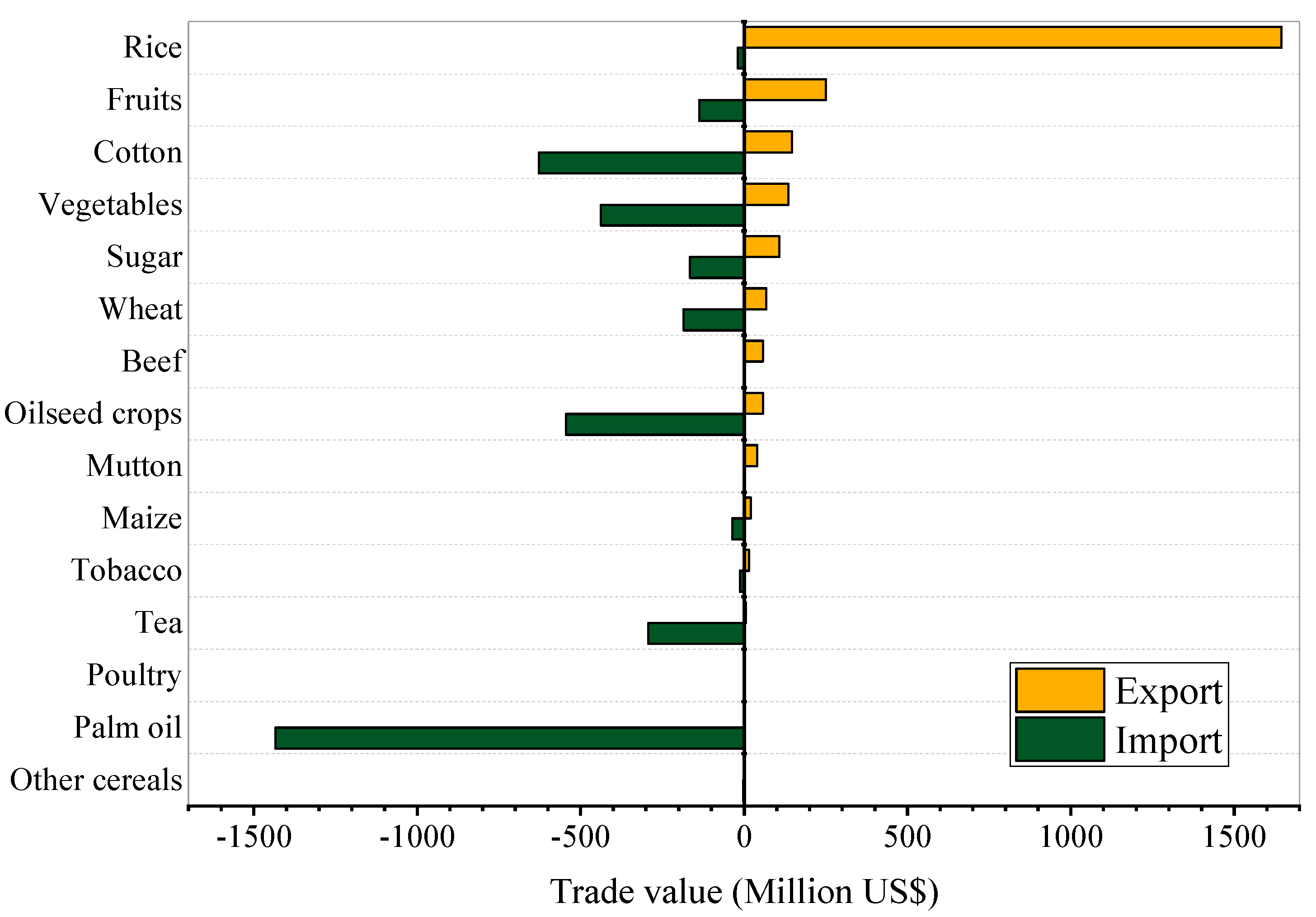
Appendix A.2. Water Resources and Use in Pakistan and its Major Trade Partners
| Country | Total Renewable Water Resources (billion m3/year) | Total Water Withdrawal (billion m3/year) | Per Capita Renewable Water Resources (m3/capita/ year) | Per Capita Water Withdrawal (m3/capita/ year) | Freshwater Withdrawal as % of Total Renewable Water Resources (%) | Ratio of Irrigated Area to Total Crop Area (%) | Water Stress Index 2 |
|---|---|---|---|---|---|---|---|
| Pakistan | 246.8 | 172.6 | 1711 | 1196 | 69.94 | 55.89 | 0.971 |
| Major export partners | |||||||
| Afghanistan | 65.33 | 20.28 | 3040 | 943.8 | 31.04 | 41.38 | 0.966 |
| China | 2840 | 549.8 | 2161 | 418.4 | 19.36 | 42.83 | 0.478 |
| Iran | 137 | 89.7 | 2024 | 1325 | 65.47 | 44.73 | 0.912 |
| Kenya | 30.7 | 2.32 | 824.1 | 62.28 | 7.557 | 1.899 | 0.021 |
| Mozambique | 217.1 | 0.8842 | 11220 | 45.7 | 0.4073 | 2.513 | 0.197 |
| Saudi Arabia | 2.4 | 23.67 | 92.01 | 907.5 | 943.3 | 44.08 | 0.995 |
| UAE | 0.15 | 2.904 | 44.2 | 855.6 | 1556 | 97.42 | 0.998 |
| USA | 3069 | 559.3 | 10639 | 1939 | 15.43 | 15.33 | 0.499 |
| Major import partners | |||||||
| Indonesia | 2019 | 113.3 | 9288 | 521.2 | 5.612 | 13.69 | 0.043 |
| Malaysia | 580 | 9.305 | 23769 | 381.3 | 1.604 | 5.101 | 0.180 |
References
- United Nations (UN). Report of the World Commission on Environment and Development: Our Common Future (the Brundtland report). 1987. Available online: http://www.un-documents.net/a42-427.htm (accessed on 10 January 2019).
- UNESCO. World Water Development Report. Water for a Sustainable World; WWAP (United Nations World Water Assessment Programme): Paris, France, 2015. [Google Scholar]
- Yang, H.; Zehnder, A.B.J. Water scarcity and food import: A case study from southern Mediterranean countries. World Dev. 2002, 30, 1413–1430. [Google Scholar] [CrossRef]
- Chapagain, A.K.; Hoekstra, A.Y. Water Footprints of Nations; Value of Water Research Report Series No. 16; UNESCO-IHE: Delft, The Netherlands, 2004. [Google Scholar]
- Chapagain, A.K.; Hoekstra, A.Y.; Savenije, H.H.G. Saving Water through Global Trade; Value of Water Research Report Series No. 17; UNESCO-IHE: Delft, The Netherlands, 2005. [Google Scholar]
- Chapagain, A.K.; Hoekstra, A.Y.; Savenije, H.H.G. Water saving through international trade of agricultural products, Hydrol. Earth Syst. Sci. 2006, 10, 455–468. [Google Scholar] [CrossRef]
- Hoekstra, A. The Relation between International Trade and Freshwater Scarcity; WTO Staff Working Paper, No. ERSD-2010-05; World Trade Organization: Geneva, Switzerland, 2010. [Google Scholar]
- Dalin, C.; Konar, M.; Hanasaki, N.; Rinaldo, A.; Rodriguez-Iturbe, I. Evolution of the global virtual water trade network. Proc. Natl. Acad. Sci. USA 2012, 109, 5989–5994. [Google Scholar] [CrossRef] [PubMed] [Green Version]
- Konar, M.; Dalin, C.; Hanasaki, N.; Rinaldo, A.; Rodriguez-Iturbe, I. Temporal dynamics of blue and green virtual water trade networks. Water Resour. Res. 2012, 48, W07509. [Google Scholar] [CrossRef]
- Mekonnen, M.M.; Hoekstra, A.Y. National Water Footprint Accounts: The Green, Blue and Grey Water Footprint of Production and Consumption; Value of Water Research Report Series No. 50; UNESCO-IHE: Delft, The Netherlands, 2011. [Google Scholar]
- Schyns, J.F.; Hoekstra, A.Y. The added value of Water Footprint Assessment for national water policy: A case study for Morocco. PLoS ONE 2014, 9, e99705. [Google Scholar] [CrossRef] [PubMed]
- Aldaya, M.M.; Martinez-Santos, P.; Llamas, M.R. Incorporating the water footprint and virtual water into policy: Reflections from the Mancha Occidental region, Spain. Water Resour. Manag. 2010, 24, 941–958. [Google Scholar] [CrossRef]
- Chouchane, H.; Krol, M.S.; Hoekstra, A.Y. Virtual water trade patterns in relation to environmental and socioeconomic factors: A case study for Tunisia. Sci. Total Environ. 2018, 613–614, 287–297. [Google Scholar] [CrossRef]
- Zoumides, C.; Bruggeman, A.; Hadjikakou, M.; Zachariadis, T. Policy-relevant indicators for semi-arid nations: The water footprint of crop production and supply utilization of Cyprus. Ecol. Indic. 2014, 43, 205–214. [Google Scholar] [CrossRef]
- Gobin, A.; Kersebaum, K.; Eitzinger, J.; Trnka, M.; Hlavinka, P.; Takáč, J.; Kroes, J.; Ventrella, D.; Dalla Marta, A.; Deelstra, J.; et al. Variability in the water footprint of arable crop production across European regions. Water 2017, 9, 93. [Google Scholar] [CrossRef]
- Allan, J.A. Virtual water: A strategic resource. Ground Water 1998, 36, 545–547. [Google Scholar] [CrossRef]
- Antonelli, M.; Tamea, S. Food-water security and virtual water trade in the Middle East and North Africa. Int. J. Water Resour. Dev. 2015, 31, 326–342. [Google Scholar] [CrossRef]
- Antonelli, M.; Tamea, S.; Yang, H. Intra-EU agricultural trade, virtual water flows and policy implications. Sci. Total Environ. 2017, 587, 439–448. [Google Scholar] [CrossRef] [PubMed]
- Allan, J.A. Virtual Water: A Long Term Solution for Water Short Middle Eastern Economies? Occasional Paper, No. 3; Water Issues Study Group, School of Oriental and African Studies, University of London: London, UK, 1997. [Google Scholar]
- Allan, J.A. Watersheds and problemsheds: Explaining the absence of armed conflict over water in the Middle East. Middle East Rev. Int. Aff. 1998, 2, 1. [Google Scholar]
- Shuval, H. ‘Virtual water’ in the water resource management of the arid Middle East. Water Resour. Middle East 2007, 2, 133–139. [Google Scholar]
- Liu, J.; Zehnder, A.J.B.; Yang, H. Historical trends in China’s virtual water trade. Water Int. 2007, 32, 78–90. [Google Scholar] [CrossRef]
- Liu, J.; Savenije, H.H.G. Food consumption patterns and their effect on water requirement in China. Hydrol. Earth Syst. Sci. 2008, 12, 887–898. [Google Scholar] [CrossRef] [Green Version]
- El-Sadek, A. Virtual water trade as a solution for water scarcity in Egypt. Water Resour. Manag. 2010, 24, 2437–2448. [Google Scholar] [CrossRef]
- Shi, J.; Liu, J.; Pinter, L. Recent evolution of China’s virtual water trade: Analysis of selected crops and considerations for policy. Hydrol. Earth Syst. Sci. 2014, 18, 1349–1357. [Google Scholar] [CrossRef]
- Dalin, C.; Hanasaki, N.; Qiu, H.; Mauzerall, D.L.; Rodriguez-Iturbe, I. Water resources transfers through Chinese interprovincial and foreign food trade. Proc. Natl. Acad. Sci. USA 2014, 111, 9774–9779. [Google Scholar] [CrossRef] [Green Version]
- Ali, T.; Huang, J.; Wang, J.; Xie, W. Global footprints of water and land resources through China’s food trade. Glob. Food Secur. 2017, 12, 139–145. [Google Scholar] [CrossRef]
- Huang, H.; Li, X.; Cao, L.; Jia, D.; Zhang, J.; Wang, C.; Han, Y. Inter-Sectoral Linkage and External Trade Analysis for Virtual Water and Embodied Carbon Emissions in China. Water 2018, 10, 1664. [Google Scholar] [CrossRef]
- Da Silva, V.; de Oliveira, S.D.; Hoekstra, A.; Neto, J.D.; Campos, J.; Braga, C.; de Araújo, L.; Aleixo, D.; de Brito, J.; de Souza, M.; et al. Water Footprint and Virtual Water Trade of Brazil. Water 2016, 8, 517. [Google Scholar] [CrossRef]
- UN. “Total Population—Both Sexes.” World Population Prospects, the 2019 Revision; United Nations Department of Economic and Social Affairs, Population Division, Population Estimates and Projections Section: New York, NY, USA, 2019. [Google Scholar]
- World Bank. Pakistan—Country Water Resources Assistance Strategy: Water Economy Running Dry (English); World Bank: Washington, DC, USA, 2005; Available online: http://documents.worldbank.org/curated/en/315851468285362706/Pakistan-Country-water-resources-assistance-strategy-water-economy-running-dry (accessed on 2 July 2018).
- UNEP. The Environment and Climate Change Outlook of Pakistan. 2008. Available online: https://www.uncclearn.org/sites/default/files/inventory/unep25082015.pdf (accessed on 29 July 2019).
- FAO. AQUASTAT Main Database, Food and Agriculture Organization of the United Nations (FAO). 2017. Available online: http://www.fao.org/nr/water/aquastat/data/query/index.html?lang=en (accessed on 12 December 2018).
- Ali, T.; Xie, W. Pakistan needs more reservoirs and fast. Nature 2018, 560, 431. [Google Scholar] [CrossRef] [PubMed]
- Dalin, C.A.C.; Wada, Y.; Kastner, T.; Puma, M.J. Groundwater depletion embedded in international food trade. Nature 2017, 543, 700–704. [Google Scholar] [CrossRef] [PubMed] [Green Version]
- De Fraiture, C.; Cai, X.; Amarasinghe, U.; Rosegrant, M.; Molden, D. Does International Cereal Trade Save Water? The Impact of Virtual Water Trade on Global Water Use; Comprehensive Assessment Research Report 4; Comprehensive Assessment Secretariat: Colombo, Sri Lanka, 2004. [Google Scholar]
- Chapagain, A.K.; Hoekstra, A.Y. The blue, green and grey water footprint of rice from production and consumption perspectives. Ecol. Econ. 2011, 70, 749–758. [Google Scholar] [CrossRef]
- Mekonnen, M.M.; Hoekstra, A.Y. The green, blue and grey water footprint of crops. Hydrol. Earth Syst. Sci. 2011, 15, 1577–1600. [Google Scholar] [CrossRef]
- FAOSTAT. FAO’s Corporate Database, 2017. Available online: http://www.fao.org/faostat/en/#data (accessed on 10 December 2018).
- DESA/UNSD. (United Nations Comtrade database), 2017. Available online: https://comtrade.un.org/data (accessed on 3 July 2018).
- Hertel, T.W. Global Trade Analysis. Modeling and Applications; Cambridge University Press: New York, NY, USA, 1997. [Google Scholar]
- Corong, E.L.; Hertel, T.W.; McDougall, R.; Tsigas, M.E.; van der Mensbrugghe, D. The Standard GTAP Model, Version 7. J. Glob. Econ. Anal. 2017, 2, 1–119. [Google Scholar]
- Nelson, G.C. Climate change effects on agriculture: Economic responses to biophysical shock. Proc. Natl. Acad. Sci. USA 2014, 111, 3274–3279. [Google Scholar] [CrossRef]
- Walmsley, T.L.; Dimaranan, B.V.; McDougall, R. A baseline scenario for the dynamic GTAP model. In Dynamic Modeling and Applications for Global Economic Analysis; Ianchovichina, E., Walmsley, T., Eds.; Cambridge University Press: New York, NY, USA, 2006; p. 136. [Google Scholar]
- Fouré, J.; Bénassy-Quéré, A.; Fontagné, L. Modelling the world economy at the 2050 horizon. Econ. Transit. 2013, 21, 617–654. [Google Scholar] [Green Version]
- Hanasaki, N. Estimating virtual water contents using a global hydrological model. In Terrestrial Water Cycle and Climate Change: Natural and Human-Induced Impacts; Tang, Q., Oki, T., Eds.; John Wiley & Sons, Inc.: Hoboken, NJ, USA, 2016. [Google Scholar] [CrossRef]
- Zoumides, C.; Bruggeman, A.; Zachariadis, T. Global versus local crop water footprints: The case of Cyprus. In Proceedings of the Session “Solving the Water Crisis: Common Action toward a Sustainable Water Footprint”, Planet under Pressure Conference, London, UK, 26 March 2012. [Google Scholar]
- Dalin, C.; Suweis, S.; Konar, M.; Hanasaki, N.; Rodriguez-Iturbe, I. Modeling past and future structure of the global virtual water trade network. Geophys. Res. Lett. 2012, 39, L24402. [Google Scholar] [CrossRef]
- Tuninetti, M.; Tamea, S.; Laio, F.; Ridolfi, L. A Fast Track approach to deal with the temporal dimension of crop water footprint. Environ. Res. Lett. 2017, 12, 074010. [Google Scholar] [CrossRef]
- Liu, J.; Savenije, H.H.G. Time to break the silence around virtual-water imports. Nature 2008, 453, 587. [Google Scholar] [CrossRef] [PubMed]
- Rosegrant, M.W.; Cai, X.; Cline, S.A. World Water and Food to 2025: Dealing with Scarcity; International Food Policy Research Institute: Washington, DC, USA, 2002. [Google Scholar]
- USDA. Pakistan: Cotton and Products Annual; Global Agricultural Information Network (GAIN): Washington, DC, USA, 2010.
- USDA. Pakistan: Cotton and Products Annual; Global Agricultural Information Network (GAIN): Washington, DC, USA, 2018.
- USDA. Pakistan: Grain and Feed Update, Wheat Update; Global Agricultural Information Network (GAIN): Washington, DC, USA, 2010. [Google Scholar]
- USDA. Pakistan Subsidizes Wheat Exports; Global Agricultural Information Network (GAIN): Washington, DC, USA, 2018.
- UNDSD. Transforming our World: The 2030 Agenda for Sustainable Development; United Nations Division for Sustainable Development: New York, NY, USA, 2015. [Google Scholar]
- Pfister, S.; Koehler, A.; Hellweg, S. Assessing the environmental impacts of freshwater consumption in LCA. Environ. Sci. Technol. 2009, 43, 4098–4104. [Google Scholar] [CrossRef]
- Fader, M.; Gerten, D.; Thammer, M.; Heinke, J.; Lotze-Campen, H.; Lucht, W.; Cramer, W. Internal and external green-blue agricultural water footprints of nations and related water and land savings through trade. Hydrol. Earth Syst. Sci. 2011, 15, 1641–1660. [Google Scholar] [CrossRef]
- Konar, M.; Hussein, Z.; Hanasaki, N.; Mauzerall, D.L.; Rodriguez-Iturbe, I. Virtual water trade flows and savings under climate change. Hydrol. Earth Syst. Sci. 2013, 17, 3219–3234. [Google Scholar] [CrossRef] [Green Version]
- Sahibzada, S.A. Pricing Irrigation Water in Pakistan: An Evaluation of Available Options. Pak. Dev. Rev. 2002, 41, 209–241. [Google Scholar] [CrossRef] [Green Version]
- UNEP. Vital Water Graphics. An Overview of the State of the World’s Fresh and Marine Waters, 2nd ed.; United Nations Environment Programme: Nairobi, Kenya, 2008; Available online: http://www.unep.org/dewa/vitalwater/article77.html (accessed on 10 March 2018).
- Yang, H.; Reichert, P.; Abbaspour, K.C.; Zehnder, A.J.B. A water resources threshold and its implications for food security. Environ. Sci. Technol. 2003, 37, 3048–3054. [Google Scholar] [CrossRef]
- Yang, H.; Wang, L.; Zehnder, A. Water scarcity and food trade in the Southern and Eastern Mediterranean countries. Food Policy 2007, 32, 585–605. [Google Scholar] [CrossRef]
- Burek, P.; Satoh, Y.; Fischer, G.; Kahil, T.; Jimenez, L.; Scherzer, A.; Tramberend, S.; Wada, Y.; Eisner, S.; Flörke, M.; et al. Final Report: Water Futures and Solution Fast Track Initiative; ADA Project Number 2725-00/2014; IIASA: Luxemburg, 2016. [Google Scholar]
- Amir, P. Agricultural Modernization through Better Water Management; Country Water Resources Assistance Strategy, Background Paper # 12; Pakistan: Country Water Resources Assistance Strategy, Water Economy: Running Dry Report No. 34081-PK; Agriculture and Rural Development Unit, South Asia Region, World Bank: Washington, DC, USA, 2005. [Google Scholar]
- Novo, P.; Garrido, A.; Varela-Ortega, C. Are virtual water “flows” in Spanish grain trade consistent with relative water scarcity? Ecol. Econ. 2009, 68, 1454–1464. [Google Scholar] [CrossRef]
- Central Intelligence Agency (CIA). The World Factbook—Central Intelligence Agency. 2018. Available online: https://www.cia.gov/library/publications/the-world-factbook/index.html (accessed on 21 June 2018).
- Faruqee, R. (Ed.) Strategic Reforms for Agricultural Growth in Pakistan; World Bank Institute (WBI) Learning Resources Series; The World Bank: Washington, DC, USA, 1999; Available online: http://documents.worldbank.org/curated/en/205781468780276574/Strategic-reforms-for-agricultural-growth-in-Pakistan (accessed on 21 July 2018). (In English)
- World Bank. Revealed Comparative Advantage of Pakistan’s Agricultural Exports; World Bank: Washington, DC, USA, 2010; Available online: http://documents.worldbank.org/curated/en/973131468064727361/Revealed-comparative-advantage-of-Pakistans-agricultural-exports (accessed on 24 February 2018). (In English)
- Evans, R.G.; Sadler, E.J. Methods and technologies to improve efficiency of water use. Water Resour. Res. 2008, 44, W00E04. [Google Scholar] [CrossRef]
- Falkenmark, M.; Widstrand, C. Population and Water Resources: A Delicate Balance; Population Bulletin 47; Population Reference Bureau, UN: Washington, DC, USA, 1992. [Google Scholar]
- Alcamo, J.; Henrichs, T. Critical regions: A model-based estimation of world water resources sensitive to global changes. Aquat. Sci. 2002, 64, 352–362. [Google Scholar] [CrossRef]
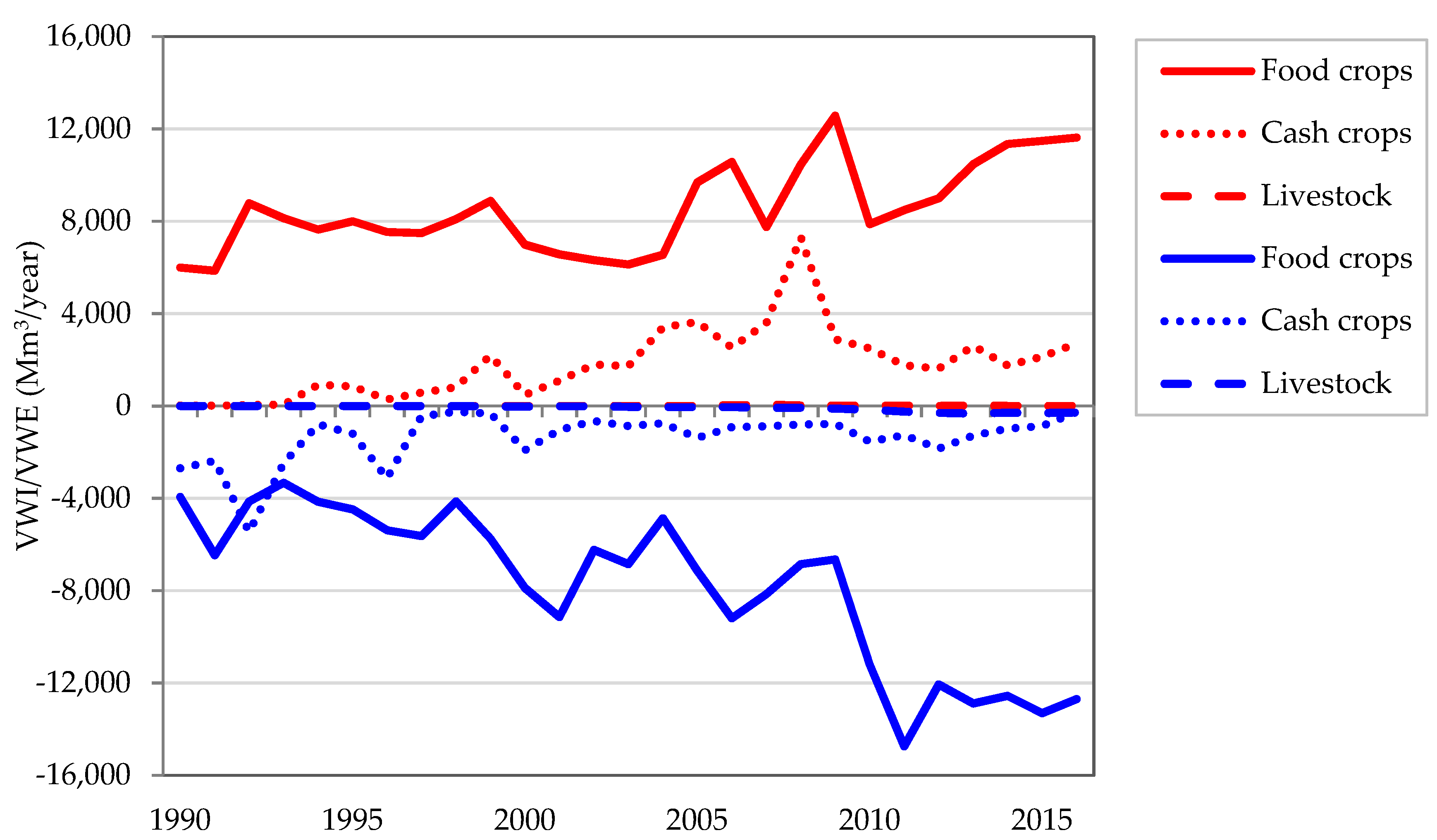

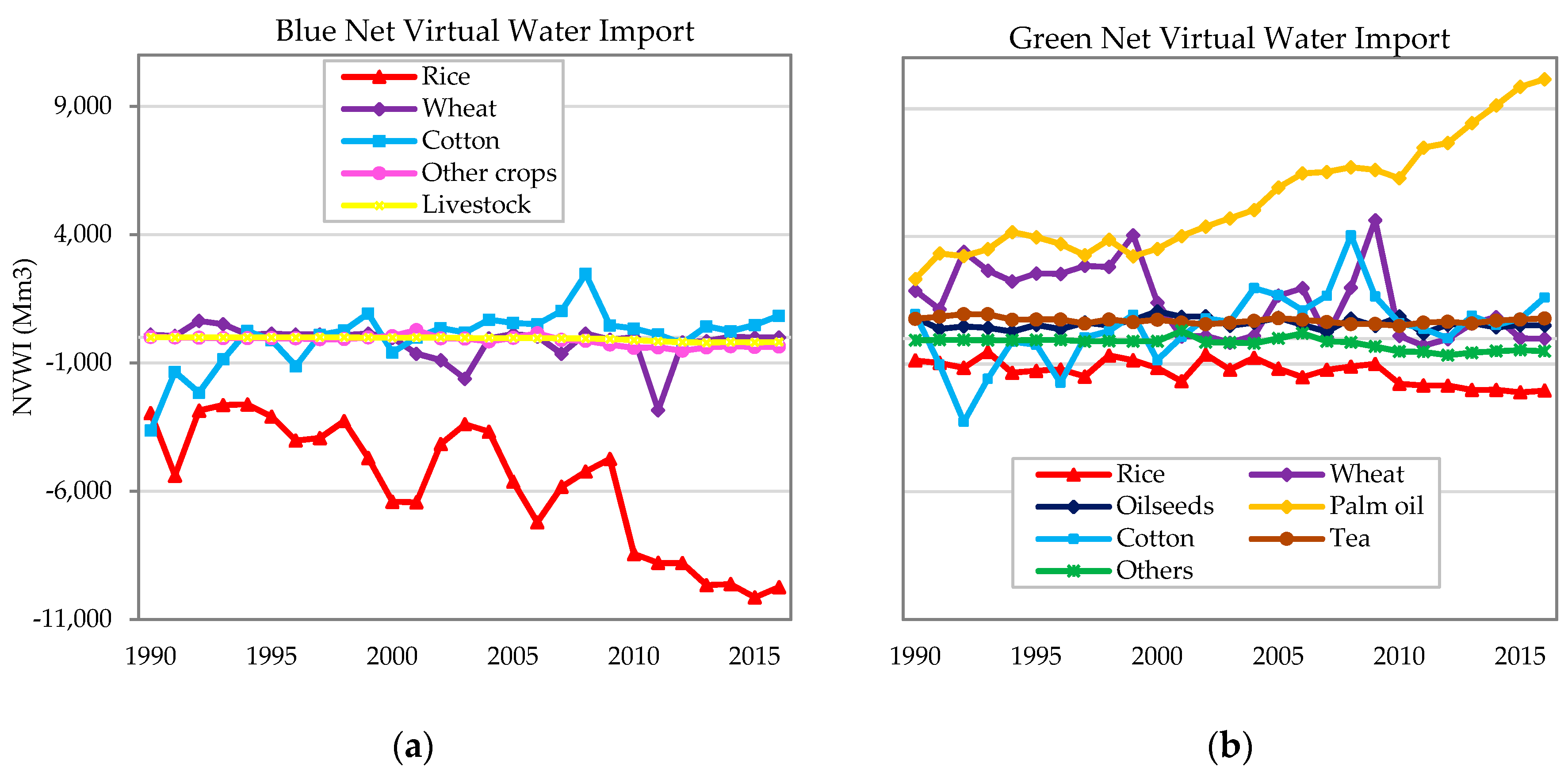
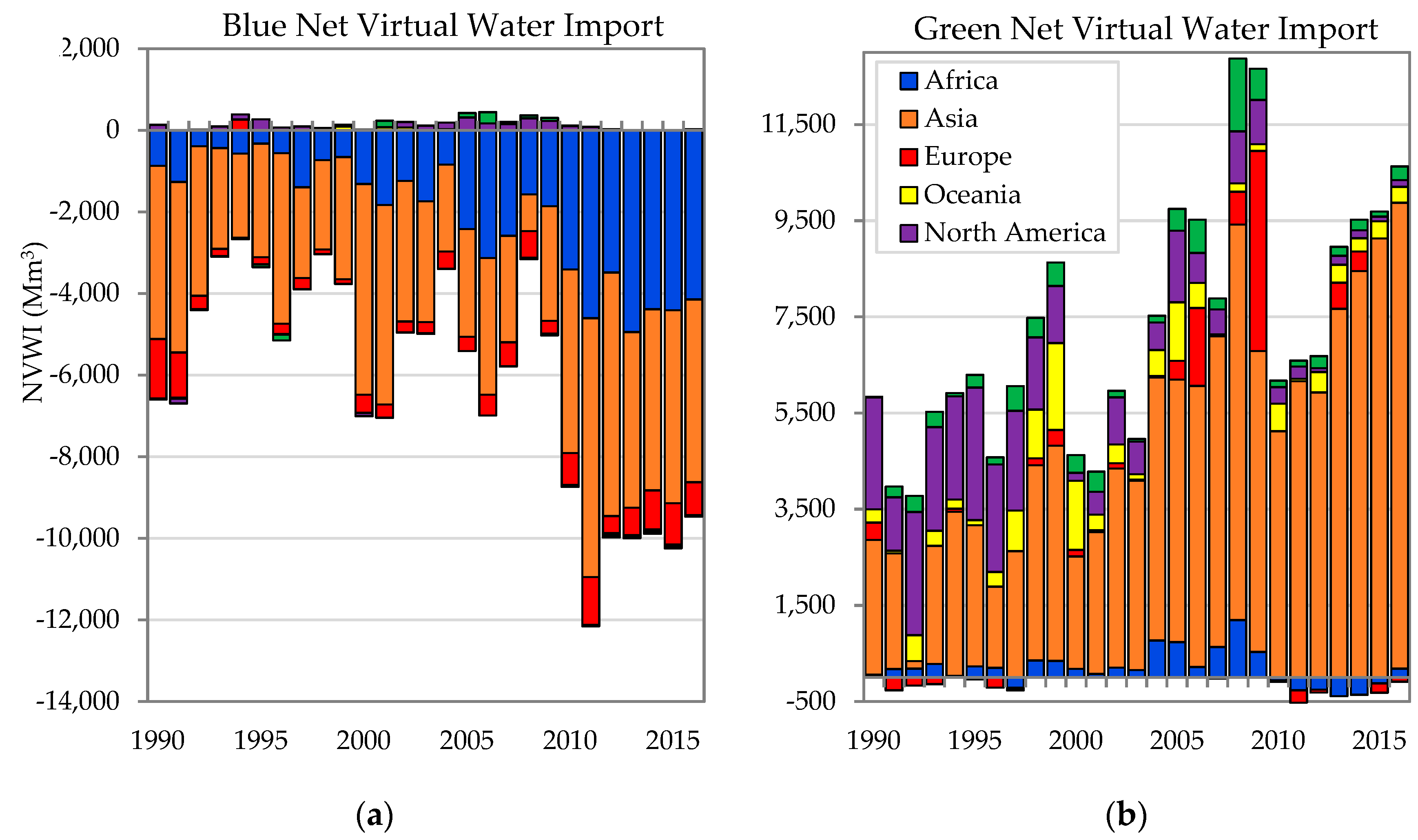
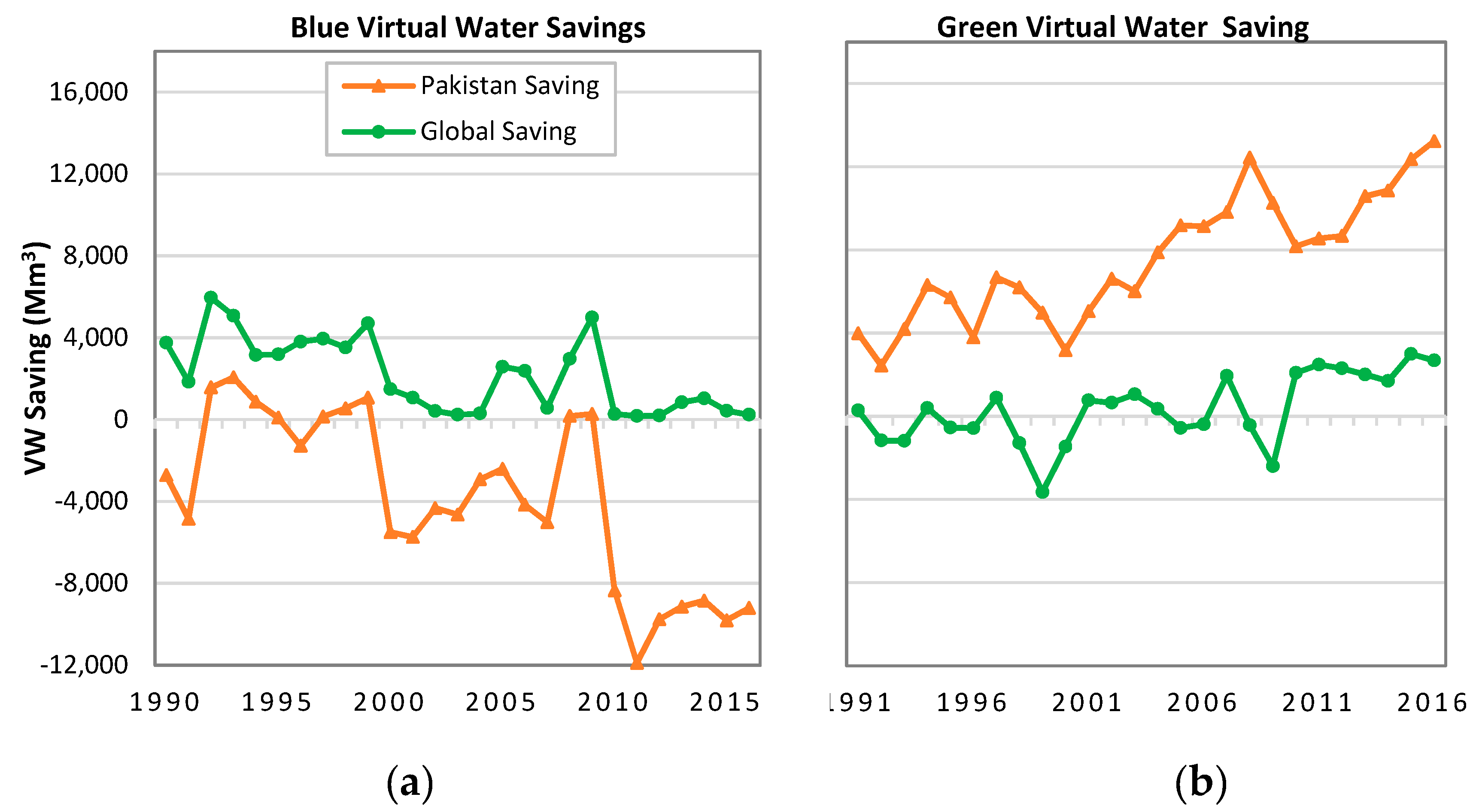

| Commodity | Period | Reference | Assumptions/Recalculations |
|---|---|---|---|
| Rice, wheat, maize, beef, mutton and poultry | 1990–2005 | [46] | Unprocessed data |
| Rice, wheat and maize | 2006–2016 | [22,46] | Recalculated VWC based on the inverse relationship between VWC and crop yield |
| Fruits and vegetables | 1996–2005 | [10] | Unprocessed values for apples (for fruits) and tomatoes (for vegetables) |
| Cotton, palm oil, tea, tobacco, other cereals and oilseeds | 1996–2005 | [10] | Unprocessed data |
| Cotton, palm oil, tea, tobacco, other cereals, oilseeds, fruits and vegetables | 1990–1995 and 2006–2016 | [10,22] | Recalculated VWC based on the inverse relationship between VWC and crop yield |
| Rice, wheat, maize, cotton, tea, tobacco, oilseeds, other cereals sugar and palm oil | 2017–2030 | [10,46,51] | Recalculated VWC values by estimating the annual improvement in the water productivities for developing and developed countries based on the forecasts on water productivity from Reference [51] |
| Fruits and vegetables | 2017–2030 | [10] | Assumed 0.5% annual improvement in water productivity |
| Beef, mutton and poultry | 2006–2030 | [46] | Assumed 1% improvement in water productivity every five years for livestock production based on the values from Reference [46] |
| Commodities | Share in Total Harvested Area (%) | Yield 1 | VWC (m3/ton) | Share of Blue VWC in Total VWC (%) | |||
|---|---|---|---|---|---|---|---|
| Pakistan | World | Blue | Green | Total | |||
| Wheat | 41.7 | 2.4 | 2.8 | 1603 | 260 | 1862 | 86.1 |
| Cotton lint 2 | 14.4 | 1.9 | 1.9 | 2781 | 4193 | 6974 | 39.9 |
| Rice | 12.0 | 3.1 | 4.0 | 2370 | 576 | 2947 | 80.4 |
| Sugar unrefined 3 | 5.1 | 5.4 | 7.3 | 2309 | 577 | 2887 | 80.0 |
| Maize | 4.9 | 2.6 | 4.6 | 1048 | 1150 | 2198 | 47.7 |
| Other cereals | 3.9 | 2.1 | 19.4 | 1048 | 1150 | 2198 | 47.7 |
| Fruits | 3.6 | 8.9 | 11.1 | 499 | 599 | 1098 | 45.4 |
| Oilseed crops | 2.6 | 4.2 | 11.4 | 617 | 1536 | 2153 | 28.7 |
| Vegetables | 2.6 | 12.7 | 16.6 | 371 | 120 | 491 | 75.6 |
| Tobacco 4 | 0.3 | 2.0 | 1.7 | 1052 | 1315 | 1315 | 80.0 |
| Palm oil | 0.0 | - | 12.2 | 0 | 4833 | 4833 | 0.0 |
| Tea | 0.0 | - | 1.4 | 9 | 8727 | 8735 | 0.1 |
| Beef | - | 147.2 | 204.5 | 11,713 | 6871 | 18,584 | 63.0 |
| Mutton | - | 16.5 | 14.3 | 5021 | 2955 | 7976 | 63.0 |
| Poultry | - | 1.1 | 1.6 | 4100 | 1388 | 5487 | 74.7 |
| Title | Green Water | Blue Water | Total |
|---|---|---|---|
| VW Import | 37,012 (178) † | 4013 (296) | 41,025 (186) |
| VW Export | 7418 (166) | 33,541 (221) | 40,959 (209) |
| VW Net Import | 29,595 (181) | −29,528 (213) | 66 (−94) |
| National Savings | 40,471 (206) | −28,999 (215) | 11,472 (185) |
| Global Savings | 10,876 (305) | 529 (121) | 11,406 (290) |
© 2019 by the authors. Licensee MDPI, Basel, Switzerland. This article is an open access article distributed under the terms and conditions of the Creative Commons Attribution (CC BY) license (http://creativecommons.org/licenses/by/4.0/).
Share and Cite
Ali, T.; Nadeem, A.M.; Riaz, M.F.; Xie, W. Sustainable Water Use for International Agricultural Trade: The Case of Pakistan. Water 2019, 11, 2259. https://doi.org/10.3390/w11112259
Ali T, Nadeem AM, Riaz MF, Xie W. Sustainable Water Use for International Agricultural Trade: The Case of Pakistan. Water. 2019; 11(11):2259. https://doi.org/10.3390/w11112259
Chicago/Turabian StyleAli, Tariq, Abdul M. Nadeem, Muhammad F. Riaz, and Wei Xie. 2019. "Sustainable Water Use for International Agricultural Trade: The Case of Pakistan" Water 11, no. 11: 2259. https://doi.org/10.3390/w11112259
APA StyleAli, T., Nadeem, A. M., Riaz, M. F., & Xie, W. (2019). Sustainable Water Use for International Agricultural Trade: The Case of Pakistan. Water, 11(11), 2259. https://doi.org/10.3390/w11112259





